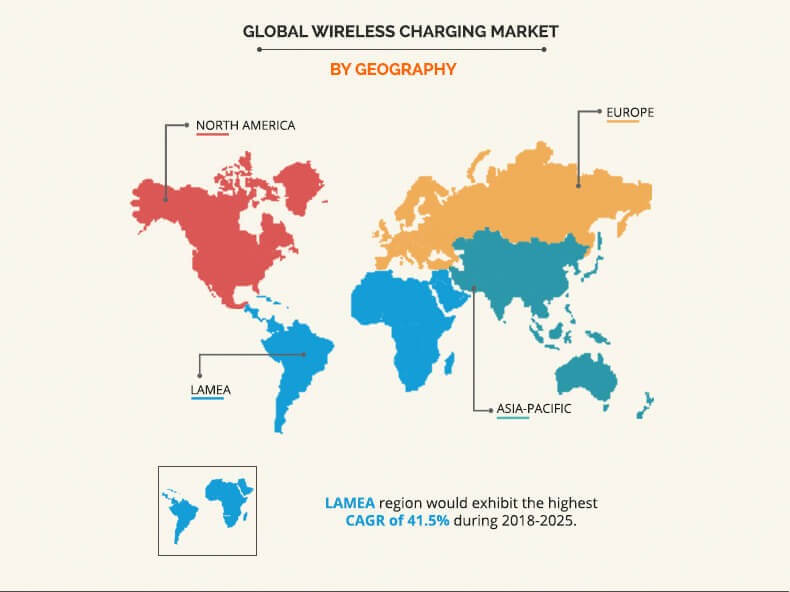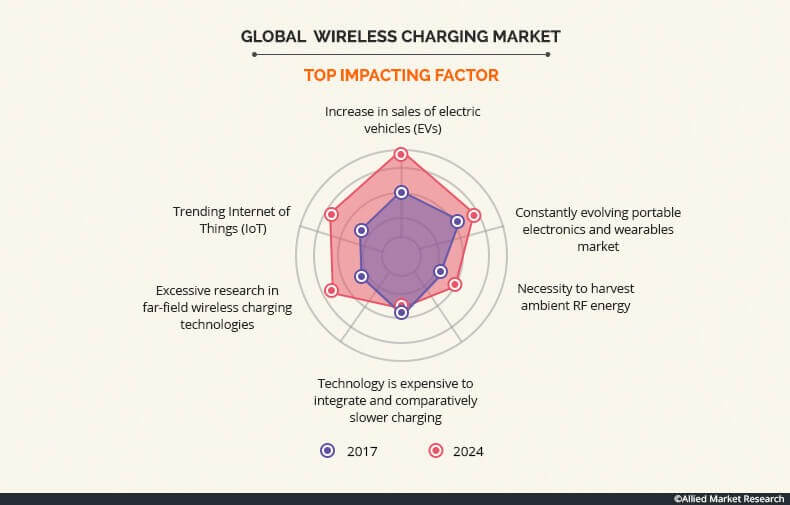Wireless Charging Market Overview:
Wireless charging is the transmission of energy without wires from a power source to a consuming device. Wireless charging devices comprise a charging station (or transmitter) that transmits the energy, and a receiver (integrated inside a device) that receives the energy and charges the battery. It is a reliable, convenient, and safe technology to power and charge electrical devices. In addition, it provides multiple efficient, cost-effective, and safer advantages over the traditional charging systems by eliminating the use of physical connectors and cables. Moreover, it maintains continuous transfer of power to ensure all varieties of devices such as handheld industrial devices, smartphones, heavy-duty equipment, and others are charged and readily available to use.
full report:- https://www.futureindustryinsight.com/product/wireless-charging-market/
Mostly wireless power transfer are generally utilized in electronic devices such as smartphones, laptops, wearable electronics, and portable devices. Such rise in adoption of efficient charging system for portable electronics and wearable, which can potentially increase the durability of the device is projected to ensure significant growth of the electronics wireless charging market. In addition, IoT is gaining popularity and is considered as the third wave of technology. Moreover, wireless charging is the primary requirement of portable electronics product targeted by IoT such as smartphones, digital camera & camcorders, laptops & tablets, wearable electronics, and household electronics .Therefore, the increase in popularity of the IoT market is expected to pose as an opportunity for the market.
The key players operating in this market are Samsung Electronics Co., Ltd., Qualcomm Incorporated, Texas Instruments, Inc., Integrated Device Technology, Inc., Powermat Technologies Ltd., WiTricity Corporation, Energizer Holdings, Inc., Murata Manufacturing Co. Ltd., Sony Corporation, and Fulton Innovation LLC.

Get more information on this report : Request Sample Pages
The global wireless charging market is segmented into technology, industry, and region. The technology segment is further divided into inductive, resonant, Radio frequency (RF), and others. The market based on industry includes electronics, automotive, industrial, healthcare, and aerospace & defense. Based on region, it is analyzed across North America, Europe, Asia-Pacific, and LAMEA.

Get more information on this report : Request Sample Pages
Top Impacting Factors
The increase in sales of electric vehicles (EVs), constant development of portable electronics and wearables market, and frequent need of harvesting ambient RF energy are expected to drive the wireless charging market during the forecast period. However, expensive technology for its integration and slower charging compared with other charging technologies are probable restraining factors for the market. Moreover, excessive research in far field wireless charging technologies and trending Internet of Things (IoT) are expected to offer lucrative opportunities in the near future.

Get more information on this report : Request Sample Pages
Increase in Sales of Electric Vehicles (EVs):
EVs offer multiple advantages such as reduced fuel (petrol, diesel, and gas) consumption and emissions from the tailpipe. These fuel the growth of the wireless charging systems. Wireless charging for electric or plug-in hybrid vehicle is certain to become ubiquitous in a short period of time. Recently, in Germany on May 28, 2018, BMW launched its wireless electric car charging system. This system allows vehicle to park over the inductive charging station followed by a simple push of the Start/Stop button to initiate the charging. Once the battery is fully charged, the system switches off automatically. The GroundPad is installed in a garage or outside to connect to the vehicle’s charging system over a distance of around eight centimeters through a magnetic field. In addition, the demonstration is done on electric vehicle with the use of wirelessly charged inductive device in Satory Versailles, France. This technology has dynamic electric vehicle charging system and is developed by Qualcomm, Renault and French mobility, which enable electric cars to charge their batteries while on the move. Such latest in trend is expected to significantly drive the wireless charging market in near future.
Frequent Need of Harvesting Ambient RF Energy:
The radio frequency (RF) energy consists of the transmitter that transmits the RF waves and a receiver is fixed within the device that receives the RF energy and converts that energy into DC voltage. This converted energy is in the form of electricity that acts as a power source for the electronic devices. Harvesting holds a promising future for generating small amount of electrical power to drive partial circuits in wirelessly communicating electronic devices. The excessive use of internet on a daily basis creates a charging problem for many smart phones & devices and that is resolved by using a fast wireless RF energy base chargers. Such rise in demand for efficient charging system is expected to significantly drive the wireless charging market.
Cost Technology is Expensive to Integrate and Comparatively Slower Charging
Slower charging rate and technology is more expensive than the traditional cable chargers, which restrict the wireless charging market. In addition, wireless charging devices have a distance limitation. RF energy technology fails when energy is to be transferred over a long distance. In electric vehicles, the charging time required is more and it varies in accordance with the vehicle battery capacity. Devices take longer to charge when the power supplied is of the same amount. Furthermore, the technology is more expensive, as inductive charging requires drive electronics and coils in the both device & charger, thus, increasing the complexity and cost of manufacturing. Newer approaches and advances in the technology reduce transfer losses and improve speed.
Key Benefits
- This study comprises of the analytical depiction of the global wireless charging market with current trends and future estimations to depict the imminent investment pockets.
- The overall market potential is determined to understand the profitable trends to gain a stronger foothold.
- The report presents information related to key drivers, restraints, and opportunities with a detailed impact analyses.
- The current market is quantitatively analyzed from 2018 to 2025 to benchmark the financial competency.
- Porter’s Five Forces analysis illustrates the potency of the buyers and suppliers in the industry.
Wireless Charging Market Key Segments:
By Technology
- Inductive
- Resonant
- Radio Frequency (RF)
- Others
By Industry Vertical
- Electronics
- Automotive
- Industrial
- Healthcare
- Aerospace & Defense
By Region
- North America
- U.S.
- Canada
- Mexico
- Europe
- UK
- Germany
- France
- Italy
- Rest of Europe
- Asia-Pacific
- China
- India
- Japan
- South Korea
- Taiwan
- Rest of Asia-Pacific
- LAMEA
- Latin America
- Middle East
- Africa
About Us:
FutureIndustryInsight™ provides quantified B2B research on 20,000 high growth emerging opportunities/threats which will impact 75% to 85% of worldwide companies’ revenues. Currently servicing 5000 customers worldwide including 80% of global Fortune 1000 companies as clients. Almost 70,000 top officers across eight industries worldwide approach FutureIndustryInsight™ for their painpoints around revenues decisions.
Media Contact:
Name: Rahul
Designation: Global Sales Manager
Ph: +17132421323
